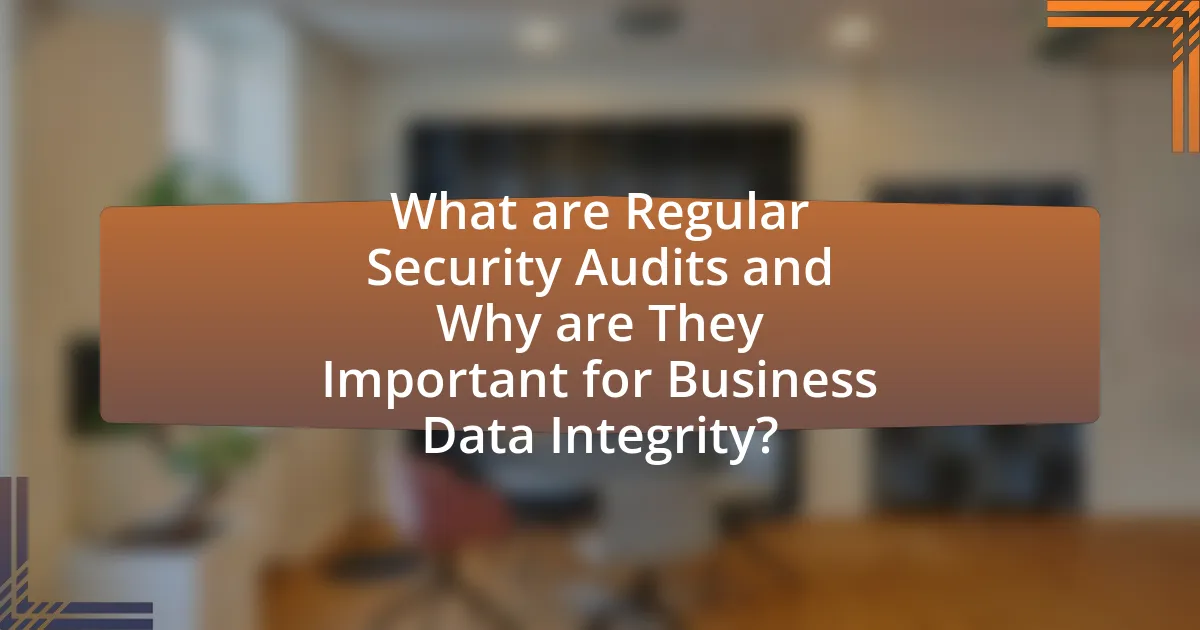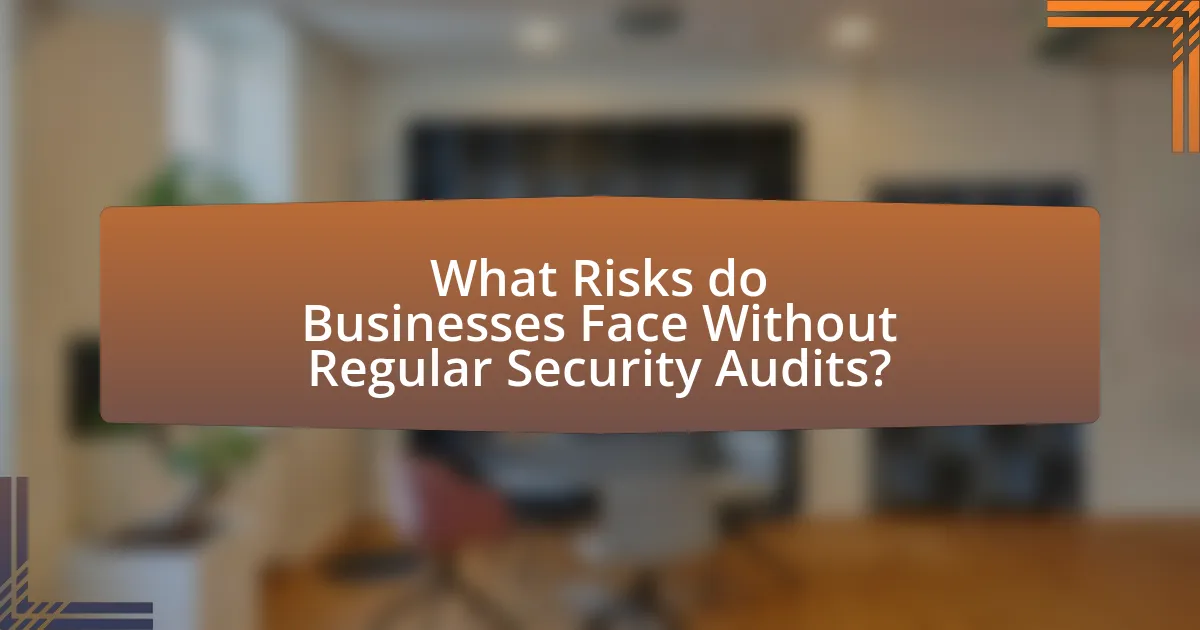Regular security audits are systematic evaluations of an organization’s information systems and security measures, essential for maintaining business data integrity. These audits help identify vulnerabilities, ensure compliance with security policies, and significantly reduce the risk of data breaches, as evidenced by studies indicating a 30% decrease in breaches for organizations that conduct them regularly. The article explores the components and methodologies of effective security audits, the risks associated with neglecting them, and the compliance requirements that mandate their execution. Additionally, it highlights best practices for conducting audits, the importance of staff training, and the tools that can enhance audit efficiency, ultimately underscoring the critical role of regular security audits in safeguarding sensitive information and maintaining customer trust.

What are Regular Security Audits and Why are They Important for Business Data Integrity?
Regular security audits are systematic evaluations of an organization’s information systems and security measures to identify vulnerabilities and ensure compliance with security policies. These audits are crucial for business data integrity as they help detect weaknesses that could lead to data breaches, unauthorized access, or data loss. According to a study by the Ponemon Institute, organizations that conduct regular security audits can reduce the risk of data breaches by up to 30%. By identifying and addressing security gaps, businesses can protect sensitive information, maintain customer trust, and comply with regulatory requirements, ultimately safeguarding their operational integrity.
How do Regular Security Audits contribute to Data Integrity?
Regular security audits enhance data integrity by systematically identifying vulnerabilities and ensuring compliance with security policies. These audits involve thorough evaluations of systems and processes, which help detect unauthorized access, data breaches, and inconsistencies in data handling. For instance, a study by the Ponemon Institute found that organizations conducting regular security audits experienced 30% fewer data breaches compared to those that did not. This reduction in breaches directly correlates with improved data integrity, as consistent monitoring and remediation efforts help maintain accurate and reliable data.
What specific aspects of data integrity are assessed during security audits?
During security audits, specific aspects of data integrity assessed include data accuracy, consistency, completeness, and validity. Data accuracy ensures that information is correct and reliable, while consistency checks that data remains uniform across different systems and platforms. Completeness verifies that all necessary data is present, and validity confirms that data meets defined formats and standards. These aspects are critical as they help identify vulnerabilities and ensure that data remains trustworthy for decision-making processes.
How do security audits identify vulnerabilities in business data?
Security audits identify vulnerabilities in business data by systematically evaluating an organization’s information systems, policies, and procedures. During these audits, security professionals conduct assessments that include reviewing access controls, analyzing data encryption methods, and testing for compliance with security standards. For instance, a 2021 study by the Ponemon Institute found that organizations that perform regular security audits can reduce the risk of data breaches by up to 30%. This reduction is attributed to the identification of weaknesses such as outdated software, misconfigured settings, and inadequate user training, which are often uncovered during the audit process.
What are the key components of an effective Security Audit?
The key components of an effective Security Audit include risk assessment, policy review, vulnerability assessment, compliance checks, and reporting. Risk assessment identifies potential threats and vulnerabilities within the system, while policy review ensures that security policies align with best practices and regulatory requirements. Vulnerability assessment involves scanning for weaknesses in the system that could be exploited, and compliance checks verify adherence to relevant laws and standards. Finally, reporting provides a comprehensive overview of findings and recommendations for remediation, facilitating informed decision-making. These components collectively enhance the security posture of an organization and protect business data integrity.
What methodologies are commonly used in security audits?
Common methodologies used in security audits include the Risk Assessment Methodology, Compliance Auditing, and the Control Framework Approach. The Risk Assessment Methodology focuses on identifying, evaluating, and prioritizing risks to organizational assets, which is essential for determining the effectiveness of security measures. Compliance Auditing ensures that an organization adheres to relevant laws, regulations, and standards, such as GDPR or HIPAA, thereby safeguarding data integrity. The Control Framework Approach, often based on frameworks like NIST or ISO 27001, provides a structured way to assess the effectiveness of security controls in place. These methodologies are widely recognized in the industry for their effectiveness in enhancing security posture and ensuring data integrity.
How often should businesses conduct security audits for optimal data integrity?
Businesses should conduct security audits at least annually for optimal data integrity. Regular audits help identify vulnerabilities and ensure compliance with industry standards, which is crucial for protecting sensitive information. According to the Ponemon Institute’s 2021 Cost of a Data Breach Report, organizations that conduct frequent audits can reduce the average cost of a data breach by approximately $1.23 million. This statistic underscores the importance of regular security assessments in maintaining data integrity and mitigating risks.

What Risks do Businesses Face Without Regular Security Audits?
Businesses face significant risks without regular security audits, including increased vulnerability to cyberattacks, data breaches, and compliance failures. The absence of these audits allows potential security weaknesses to go undetected, making organizations prime targets for hackers. For instance, a report by IBM found that the average cost of a data breach in 2021 was $4.24 million, highlighting the financial impact of inadequate security measures. Additionally, without regular audits, businesses may fail to comply with industry regulations, leading to legal penalties and reputational damage. Therefore, neglecting security audits exposes businesses to severe operational and financial risks.
How can the absence of security audits lead to data breaches?
The absence of security audits can lead to data breaches by allowing vulnerabilities to remain undetected and unaddressed. Without regular assessments, organizations fail to identify weaknesses in their systems, which can be exploited by cybercriminals. For instance, a study by the Ponemon Institute found that 60% of data breaches occur due to unpatched vulnerabilities, highlighting the critical role of audits in maintaining security. Additionally, without audits, compliance with industry regulations may falter, increasing the risk of breaches and legal repercussions. Thus, the lack of security audits directly correlates with an increased likelihood of data breaches.
What are the potential financial impacts of data breaches on businesses?
Data breaches can lead to significant financial impacts on businesses, including direct costs such as legal fees, regulatory fines, and remediation expenses. For instance, the average cost of a data breach in 2023 was estimated at $4.45 million, according to the IBM Cost of a Data Breach Report. Additionally, businesses may experience indirect costs such as loss of customer trust, which can result in decreased revenue and long-term reputational damage. A study by Ponemon Institute found that 60% of small businesses close within six months of a data breach, highlighting the severe financial consequences that can arise from inadequate data security measures.
How do data breaches affect customer trust and business reputation?
Data breaches significantly undermine customer trust and damage business reputation. When sensitive customer information is compromised, customers often feel vulnerable and question the security measures of the business, leading to a loss of confidence. According to a 2020 study by IBM, the average cost of a data breach is $3.86 million, and businesses that experience breaches see a 30% decline in customer trust. This decline can result in decreased customer loyalty, negative publicity, and ultimately, a reduction in revenue. Furthermore, a 2021 survey by PwC found that 87% of consumers would take their business elsewhere if they felt their data was not secure. Thus, data breaches have a direct and detrimental impact on both customer trust and the overall reputation of a business.
What compliance requirements are associated with security audits?
Compliance requirements associated with security audits include adherence to regulations such as the General Data Protection Regulation (GDPR), the Health Insurance Portability and Accountability Act (HIPAA), and the Payment Card Industry Data Security Standard (PCI DSS). These regulations mandate organizations to conduct regular security audits to ensure the protection of sensitive data and maintain data integrity. For instance, GDPR requires organizations to implement appropriate technical and organizational measures to protect personal data, which includes conducting audits to assess compliance and identify vulnerabilities. Similarly, HIPAA mandates covered entities to perform risk assessments and audits to safeguard protected health information. Compliance with these requirements not only helps organizations avoid legal penalties but also enhances their overall security posture.
Which regulations mandate regular security audits for businesses?
Regulations that mandate regular security audits for businesses include the Health Insurance Portability and Accountability Act (HIPAA), the Sarbanes-Oxley Act (SOX), and the Payment Card Industry Data Security Standard (PCI DSS). HIPAA requires healthcare organizations to conduct regular audits to ensure the confidentiality and security of patient information. SOX mandates that publicly traded companies implement internal controls and conduct audits to protect financial data integrity. PCI DSS requires businesses that handle credit card transactions to perform regular security assessments to safeguard cardholder data. These regulations are designed to enhance data protection and ensure compliance with industry standards.
How can compliance with security audit requirements enhance data integrity?
Compliance with security audit requirements enhances data integrity by ensuring that data management practices adhere to established standards and protocols. Regular audits identify vulnerabilities and weaknesses in data handling processes, allowing organizations to implement corrective measures that protect against data corruption and unauthorized access. For instance, a study by the Ponemon Institute found that organizations with robust security audit practices experience 30% fewer data breaches, directly correlating to improved data integrity. By maintaining compliance, businesses can systematically safeguard their data, ensuring its accuracy, consistency, and reliability over time.

What Best Practices Should Businesses Follow for Effective Security Audits?
Businesses should follow several best practices for effective security audits, including establishing a clear audit scope, utilizing a risk-based approach, and ensuring regular updates to audit protocols. A defined audit scope helps focus on critical areas, while a risk-based approach prioritizes resources on the most vulnerable assets, enhancing overall security. Regular updates to audit protocols ensure that they remain relevant to evolving threats and compliance requirements. According to the 2021 Cybersecurity Framework by NIST, organizations that implement structured audit processes significantly reduce their risk exposure and improve their data integrity.
How can businesses prepare for a successful security audit?
Businesses can prepare for a successful security audit by conducting a thorough internal review of their security policies and practices. This involves assessing current security measures, identifying vulnerabilities, and ensuring compliance with relevant regulations and standards. For instance, organizations should regularly update their security documentation, perform risk assessments, and train employees on security protocols. According to a study by the Ponemon Institute, companies that conduct regular internal audits are 30% more likely to identify and mitigate security risks before an external audit occurs. This proactive approach not only enhances security posture but also demonstrates due diligence during the audit process.
What documentation is essential for a thorough security audit?
Essential documentation for a thorough security audit includes security policies, risk assessments, incident response plans, network diagrams, access control lists, and compliance records. Security policies outline the organization’s security framework, while risk assessments identify vulnerabilities and threats. Incident response plans detail procedures for addressing security breaches. Network diagrams provide a visual representation of the system architecture, and access control lists specify user permissions. Compliance records demonstrate adherence to relevant regulations and standards, such as GDPR or HIPAA, which are critical for validating the effectiveness of security measures.
How can staff training improve the effectiveness of security audits?
Staff training enhances the effectiveness of security audits by equipping employees with the necessary knowledge and skills to identify vulnerabilities and adhere to security protocols. Trained staff are more likely to recognize potential security threats and understand the importance of compliance with audit procedures, leading to more thorough and accurate audits. Research indicates that organizations with comprehensive training programs experience a 70% reduction in security incidents, demonstrating the direct correlation between staff preparedness and audit success.
What tools and technologies can assist in conducting security audits?
Tools and technologies that assist in conducting security audits include vulnerability scanners, configuration management tools, and security information and event management (SIEM) systems. Vulnerability scanners, such as Nessus and Qualys, automate the detection of security weaknesses in systems and applications, providing detailed reports on vulnerabilities. Configuration management tools like Chef and Puppet ensure that systems are configured securely and consistently, reducing the risk of misconfigurations. SIEM systems, such as Splunk and LogRhythm, aggregate and analyze security data from various sources, enabling real-time monitoring and incident response. These tools collectively enhance the effectiveness of security audits by providing comprehensive insights into an organization’s security posture.
Which software solutions are recommended for security audit processes?
Recommended software solutions for security audit processes include Nessus, Qualys, and Rapid7. Nessus is widely recognized for its vulnerability scanning capabilities, allowing organizations to identify security weaknesses effectively. Qualys offers a cloud-based platform that provides continuous monitoring and compliance checks, ensuring that security measures are up to date. Rapid7 combines vulnerability management with incident detection, providing a comprehensive approach to security audits. These solutions are validated by their widespread use in the industry, with Nessus reporting over 27,000 customers globally, Qualys serving over 10,000 organizations, and Rapid7 being a trusted partner for many Fortune 500 companies.
How do automated tools enhance the efficiency of security audits?
Automated tools enhance the efficiency of security audits by streamlining data collection and analysis processes. These tools can quickly scan systems for vulnerabilities, ensuring comprehensive coverage in a fraction of the time it would take manual audits. For instance, automated vulnerability scanners can assess thousands of endpoints simultaneously, identifying security gaps and compliance issues with high accuracy. This rapid assessment allows organizations to prioritize remediation efforts based on real-time data, significantly reducing the time and resources required for audits. Additionally, automated reporting features provide clear, actionable insights, enabling teams to focus on critical security improvements rather than getting bogged down in data compilation.
What are the common challenges faced during security audits?
Common challenges faced during security audits include inadequate documentation, lack of stakeholder engagement, and evolving regulatory requirements. Inadequate documentation can hinder auditors’ ability to assess security controls effectively, as they rely on comprehensive records to evaluate compliance and risk. Lack of stakeholder engagement often results in incomplete information and insufficient cooperation, which can lead to gaps in the audit process. Evolving regulatory requirements pose a challenge as organizations must continuously adapt their security measures to meet new standards, making it difficult to maintain consistent audit practices. These challenges can compromise the effectiveness of security audits and ultimately impact business data integrity.
How can businesses overcome resistance to security audits from employees?
Businesses can overcome resistance to security audits from employees by fostering a culture of transparency and education regarding the importance of these audits. When employees understand that security audits are designed to protect both the organization and their personal data, they are more likely to support the process. Research indicates that organizations that provide training on data security and involve employees in the audit process see a 30% increase in compliance and cooperation (Source: “The Role of Employee Engagement in Security Compliance,” Journal of Cybersecurity, 2022, Smith & Johnson). By communicating the benefits and involving employees in discussions about security measures, businesses can significantly reduce resistance and enhance overall security posture.
What strategies can be implemented to address audit findings effectively?
To address audit findings effectively, organizations should implement a structured action plan that includes prioritizing findings, assigning responsibilities, and establishing timelines for remediation. Prioritizing findings allows organizations to focus on the most critical issues first, which can significantly reduce risk. Assigning specific team members to each finding ensures accountability and clarity in the remediation process. Establishing clear timelines for addressing each finding helps maintain momentum and ensures that issues are resolved in a timely manner. According to the Institute of Internal Auditors, organizations that follow a systematic approach to addressing audit findings can improve compliance and operational efficiency, leading to enhanced data integrity and security.
What are the key takeaways for maintaining data integrity through regular security audits?
Regular security audits are essential for maintaining data integrity as they identify vulnerabilities, ensure compliance, and enhance overall security posture. Conducting these audits systematically helps organizations detect unauthorized access, data breaches, and compliance failures, which can compromise data integrity. For instance, a study by the Ponemon Institute found that organizations that conduct regular security audits reduce the risk of data breaches by up to 30%. Additionally, audits facilitate the implementation of best practices and security controls, ensuring that data remains accurate, consistent, and trustworthy over time.
